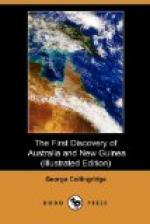Their interments are covered. We saw some enclosed burial grounds with oratories and carved figures, to which they make offerings. It is, to all appearance, a courageous and sociable people, but without care for the ills of their neighbours; for they saw some fighting with us without coming to help them.
The houses are of wood, covered with palm-leaves, with two sloping sides to the roof, and with a certain kind of outhouse, where they keep their food. All their things are kept very clean.
They also have flower-pots with small trees of an unknown kind. The leaves are very soft, and of a yellow-reddish colour.
The bread they use is mainly of roots, whose young shoots climb on poles, which are put near them for that purpose.* The rind is grey, the pulp murrey colour, yellow, or reddish; some much larger than others. There are some a yard and a half in thickness, also two kinds; one almost round, and the size of two fists, more or less. Their taste resembles the potatoes of Peru. The inside of the other root is white, its form and size that of a cob of maize when stripped. All these kinds have a pulp without fibres, loose, soft, and pleasant to the taste. These roots are bread made without trouble, there being nothing to do but to take them out of the earth, and eat them, roast or boiled. They are very good cooked in pots. Our people ate a great deal; and, being of a pleasant taste and satisfying, they left off the ship’s biscuit for them. These roots last so long without getting bad, that on reaching Acapulco those that were left were quite good.
[* The Kumara, or sweet potato, and yams.]
Their meat consists of a great quantity of tame pigs, some reddish, others black, white, or speckled. We saw tusks 11/4 palmos in length, and a porker was killed weighing 200 lbs. The natives roast them on hearths, wrapped up in plantain leaves. It is a clean way, which gives the meat a good colour, and none of the substance is lost.
There are many fowls like those of Europe. They use capons. There are many wild pigeons, doves, ducks, and birds like partridges, with very fine plumage. One was found in a lasso, with which the natives catch them. There are many swallows; we saw a macaw and flocks of paraquets; and we heard, when on board at early dawn, a sweet harmony from thousands of different birds, apparently buntings, blackbirds, nightingales, and others. The mornings and afternoons were enjoyable from the pleasant odours emitted from the trees and many kinds of flowers, together with the sweet basil. A bee was also seen, and harvest flies were heard buzzing.
The fish are skate, sole, pollack, red mullet, shad, eels, pargos, sardines, and others; for which natives fish with a three-pronged dart, with thread of a fibrous plant, with nets in a bow shape, and at night with a light. Our people fished with hooks and with nets for the most part. In swampy parts of the beach shrimps and mussels were seen.




